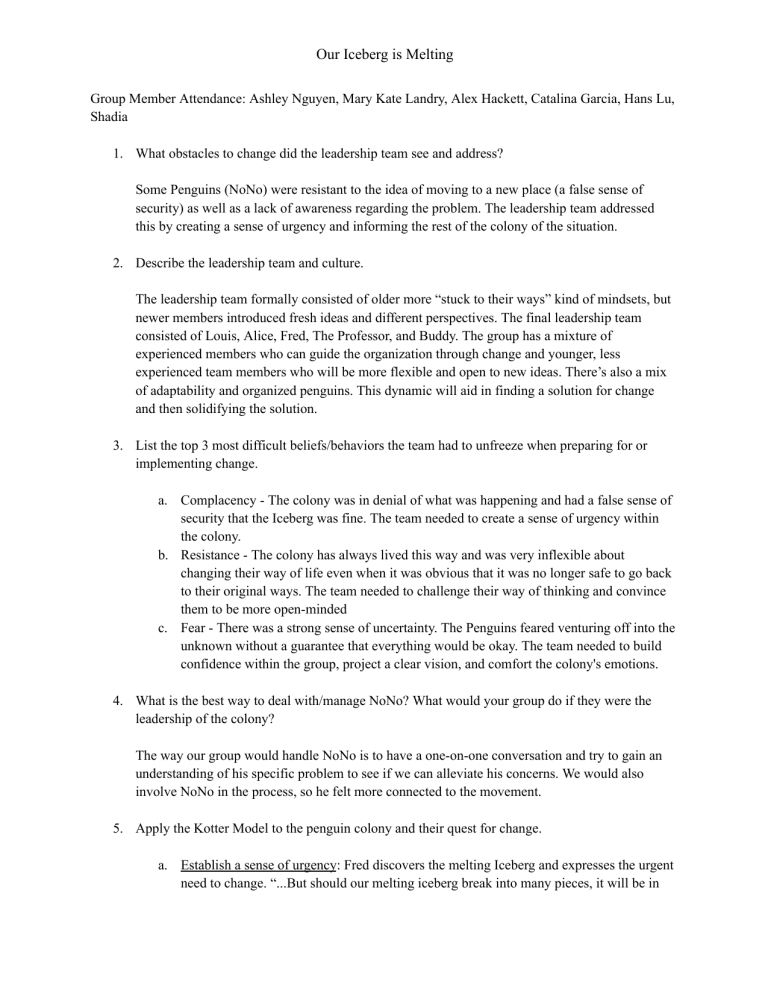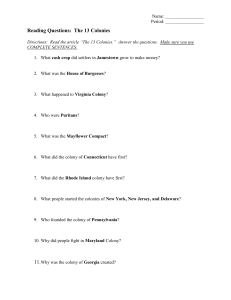
Our Iceberg is Melting Group Member Attendance: Ashley Nguyen, Mary Kate Landry, Alex Hackett, Catalina Garcia, Hans Lu, Shadia 1. What obstacles to change did the leadership team see and address? Some Penguins (NoNo) were resistant to the idea of moving to a new place (a false sense of security) as well as a lack of awareness regarding the problem. The leadership team addressed this by creating a sense of urgency and informing the rest of the colony of the situation. 2. Describe the leadership team and culture. The leadership team formally consisted of older more “stuck to their ways” kind of mindsets, but newer members introduced fresh ideas and different perspectives. The final leadership team consisted of Louis, Alice, Fred, The Professor, and Buddy. The group has a mixture of experienced members who can guide the organization through change and younger, less experienced team members who will be more flexible and open to new ideas. There’s also a mix of adaptability and organized penguins. This dynamic will aid in finding a solution for change and then solidifying the solution. 3. List the top 3 most difficult beliefs/behaviors the team had to unfreeze when preparing for or implementing change. a. Complacency - The colony was in denial of what was happening and had a false sense of security that the Iceberg was fine. The team needed to create a sense of urgency within the colony. b. Resistance - The colony has always lived this way and was very inflexible about changing their way of life even when it was obvious that it was no longer safe to go back to their original ways. The team needed to challenge their way of thinking and convince them to be more open-minded c. Fear - There was a strong sense of uncertainty. The Penguins feared venturing off into the unknown without a guarantee that everything would be okay. The team needed to build confidence within the group, project a clear vision, and comfort the colony's emotions. 4. What is the best way to deal with/manage NoNo? What would your group do if they were the leadership of the colony? The way our group would handle NoNo is to have a one-on-one conversation and try to gain an understanding of his specific problem to see if we can alleviate his concerns. We would also involve NoNo in the process, so he felt more connected to the movement. 5. Apply the Kotter Model to the penguin colony and their quest for change. a. Establish a sense of urgency: Fred discovers the melting Iceberg and expresses the urgent need to change. “...But should our melting iceberg break into many pieces, it will be in Our Iceberg is Melting b. c. d. e. f. g. h. winter, when it is dark both day and night when the terrible storms and winds make us most vulnerable.” Creating a guiding coalition: Assembled the leadership team of 5 who are respected by the colony and have the relevant knowledge to lead the group to a new home. Developing a coalition and strategy: The team agreed on the plan to find a new home and adapt to the changing environment (like seagulls). They would do that by migrating and practicing new ways of nesting. Communicate the change vision: - The team had brought the clan together for a meeting and Buddy started by telling the seagull’s story, but it was confusing for some. Louis then brought it down to simpler terms and 80% now had an idea of the plan. Empower Employees: They empowered their fellow penguins by training their colony to swim and hunt differently, as well as prepare them for the migration. They also encouraged all penguins to contribute to the change effort. Generate short-term wins: During their journey, the clan had successful fishing trips and luck in finding a new nesting site. Highlighting these small wins kept them motivated and helpful during the change process. Consolidate gains and produce more change: The penguins continued the momentum by improving their strategies for survival and building upon their gains until the change seeped into the deepest recesses of their colony. Anchor the new approaches in the culture: After some time, the new behaviors and practices became the norm. They embedded these approaches into their life style and now thrive in their new environment.





